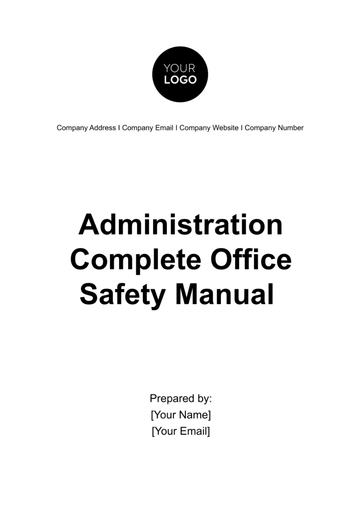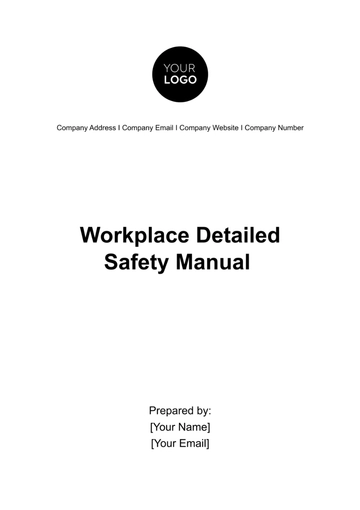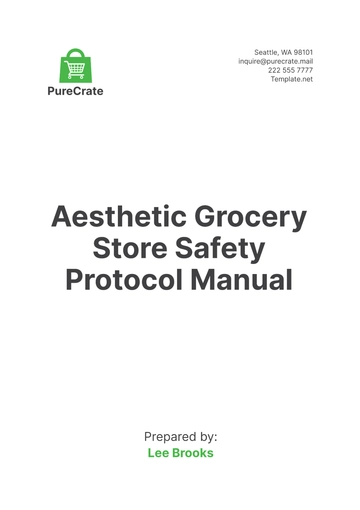Free PPE Training Manual

I. Introduction
A. Purpose
This manual is created with the utmost dedication to the safety and well-being of our workforce. The primary purpose of this PPE Training Manual is to ensure that every member of our company possesses a thorough understanding of personal protective equipment. By equipping individuals with the necessary knowledge and skills, we aim to create a workplace culture where the correct use, care, and maintenance of PPE become second nature.
B. Scope
This manual encompasses a broad spectrum of PPE-related information, covering various types of equipment, their applications, and the procedures for selecting, using, and maintaining them. It serves as a reference guide for employees across different roles and responsibilities within our company.
C. Target Audience
Designed to cater to the diverse workforce within our company, this manual is intended for every employee, from frontline workers to managerial staff. It ensures that individuals at all levels are well-informed about the importance of PPE and are equipped to make informed decisions regarding their safety.
II. Objectives
A. Raise Awareness
Increase awareness among employees about the significance of using PPE as a fundamental aspect of workplace safety.
B. Enhance Competence
Enhance the competence of individuals in the correct selection, use, and maintenance of various types of PPE.
C. Reduce Incidents
Contribute to a reduction in workplace incidents and injuries through the proper implementation of PPE protocols.
D. Establish Consistency
Establish consistency in PPE practices across all departments and job roles within the company.
III. Types of PPE
Understanding the diverse types of PPE is essential for creating a comprehensive safety culture. This section details ten distinct categories of PPE, each serving a specific purpose in safeguarding our employees.
A. Eye Protection
Safety glasses, goggles, and face shields designed to protect against eye hazards, including flying particles and chemicals.
B. Hearing Protection
Earplugs and earmuffs designed to safeguard against excessive noise levels, preventing hearing damage.
C. Respiratory Protection
Masks and respirators designed to protect against airborne contaminants, ensuring safe breathing in various environments.
D. Head Protection
Helmets designed to protect the head from impact, falling objects, and electrical hazards.
E. Hand Protection
Gloves designed to shield hands from various hazards such as chemicals, cuts, and abrasions.
F. Foot Protection
Safety boots and shoes designed to protect the feet from falling objects, compression, and electrical hazards.
G. Body Protection
Coveralls, vests, and aprons designed to protect the body from a range of hazards, including chemicals and biohazards.
H. Fall Protection
Harnesses and lanyards designed to prevent falls from heights, a critical consideration for those working at elevated positions.
I. Skin Protection
Sunscreen and protective clothing designed to shield the skin from harmful UV rays and environmental elements.
J. Hearing Enhancement
Communication devices and hearing amplifiers designed to enhance communication and hearing in noisy environments.
K. Headsets and Communication Devices
Devices designed to facilitate clear communication in loud environments, ensuring effective teamwork and coordination.
IV. Selection of PPE
A. Choosing the Right PPE for the Job
Selecting the appropriate PPE is a critical step in ensuring personal safety. Consider the nature of the job, potential hazards, and the specific requirements outlined in job safety analyses. Employees should choose PPE that provides the highest level of protection without compromising comfort or efficiency.
B. Individual Fit and Comfort
PPE should be individually fitted to ensure maximum effectiveness and comfort. Ill-fitting equipment can be a safety risk, and employees must report any discomfort or issues promptly. Comfortable PPE encourages consistent usage, contributing to overall safety compliance.
C. Compliance with Standards
All selected PPE must comply with relevant safety standards and regulations. Regularly check for certification labels and markings to guarantee that the equipment meets the necessary safety requirements. Non-compliant PPE should not be used and must be reported to supervisors.
D. Assessing the Environmental Conditions
Consider the specific environmental conditions of the job when selecting PPE. Different tasks may require adjustments to account for factors such as extreme temperatures, chemical exposure, or confined spaces. Ensure that the chosen PPE is suitable for the environmental demands of the job.
V. Proper Use and Wear
A. Putting on PPE
Follow the step-by-step guidelines for correctly putting on each type of PPE which is outlined in the table below:
PPE Type | Instructions |
[Eye Protection] | [Wash hands, adjust for a secure fit and place over eyes] |
Ensuring the proper and meticulous donning of Personal Protective Equipment (PPE) is paramount to safeguarding the well-being of individuals in diverse workplace environments. The correct application of PPE serves as a crucial barrier against potential hazards, ranging from physical injuries to exposure to harmful substances. Following the prescribed procedures for putting on PPE is a fundamental practice that significantly reduces the risk of accidents and occupational health issues. By adhering to these guidelines, individuals contribute not only to their personal safety but also to fostering a culture of collective responsibility, emphasizing the shared commitment to a secure and healthy work environment.
B. Ensuring a Secure Fit
PPE should fit securely without being too tight or too loose. Straps, closures, and adjustments must be correctly fastened to prevent slippage during use. Regularly check for proper fit, especially if the job involves movement or physical activity.
C. Conducting Fit Tests
For certain types of PPE, such as respirators, conduct fit tests as required. Fit tests ensure an airtight seal, essential for respiratory protection. Only use respirators that have passed fit testing to guarantee the safety of the user.
D. Minimizing Adjustments During Use
Once donned, avoid unnecessary adjustments to PPE during work. Frequent adjustments may compromise the integrity of the equipment. If adjustments are required, do so in a safe environment, away from potential hazards.
E. Removing PPE Safely
Follow the recommended procedures for removing PPE to prevent contamination or injury. This includes avoiding contact with the outer surfaces, using designated removal areas, and disposing of disposable PPE in designated containers.
F. Cleaning and Maintenance
Regularly clean and maintain PPE according to the manufacturer's guidelines. This may involve washing, disinfecting, or inspecting for damage. Ensure that all components, such as straps and closures, are in good condition before each use.
G. Storage and Inspection
Store PPE in designated areas away from direct sunlight, extreme temperatures, and chemical exposure. Regularly inspect stored equipment for signs of wear, damage, or deterioration. Damaged PPE should be replaced immediately.
H. Rotation and Replacement
Rotate PPE as needed, especially for items with a limited lifespan or those subjected to frequent use. Establish a schedule for routine replacement based on manufacturer recommendations, wear and tear, or changes in safety standards.
I. Reporting Issues
Employees should notify supervisors of damaged equipment, discomfort, or any unforeseen challenges during the use of PPE.
VII. Maintenance and Care
A. Routine Cleaning Procedures
Follow manufacturer guidelines for cleaning methods and use recommended cleaning agents. Regular cleaning helps maintain the integrity of the equipment and ensures it remains free from contaminants.
B. Inspection Before Use
Before each use, inspect PPE for any signs of wear, damage, or deterioration. Check components such as straps, buckles, lenses, and closures for proper functioning. If any issues are identified, report them immediately and replace the equipment if necessary.
C. Storage Guidelines
Store equipment in designated areas that protect it from sunlight, extreme temperatures, and exposure to chemicals. Avoid hanging or stacking PPE in a way that may compromise its structure or shape.
D. Specialized Maintenance Procedures
Certain types of PPE may require specialized maintenance procedures. Familiarize yourself with the manufacturer's recommendations for specific equipment, such as the care of respiratory masks or the storage requirements for electronic components.
VII. Limitations and Restrictions
A. Understanding PPE Limitations
While PPE provides essential protection, it may not eliminate all risks. Employees should be aware of the specific hazards that each piece of equipment is designed to address and understand its limitations.
B. Restricted Environments
Some environments may pose challenges for certain types of PPE. Trainers must communicate any restrictions on PPE use in specific work areas, such as confined spaces or areas with high levels of contamination. Employees should be aware of and adhere to these restrictions.
C. Alternatives and Combinations
In situations where a single type of PPE may not provide adequate protection, consider alternative or complementary options. For example, combining earplugs with earmuffs may offer enhanced hearing protection. Seek guidance from supervisors for the best approach in such cases.
D. User-Specific Limitations
Certain medical conditions or personal factors may impact the suitability of specific equipment for an individual. Employees should communicate any concerns or limitations to supervisors.
VIII. Emergency
A. Emergency Evacuation Protocols
Ensure that PPE is properly worn during evacuations to provide continuous protection. Familiarize yourself with evacuation routes and assembly points relevant to your work area.
B. Communication during Emergencies
Maintain clear communication during emergencies, especially when using PPE that may impede verbal communication. Use designated communication devices, signals, or gestures as outlined in emergency response plans.
C. Coordination with First Responders
If first responders are involved, coordinate with them and follow their instructions. Provide information about the type of PPE worn and any hazards present to ensure a swift and safe response to the emergency.
D. Post-Emergency PPE Assessment
After an emergency, safety officers must assess the condition of PPE. Inspect for damage or contamination, and report any issues promptly. Follow established decontamination procedures if required, and replace any damaged or compromised equipment.
IX. Training and Recordkeeping
A. Training Sessions
Training sessions should be conducted regularly, covering updates in safety protocols, new equipment introductions, and any changes in regulations. Engage employees in practical demonstrations to reinforce theoretical knowledge.
B. Trainer Qualifications
Trainers should possess in-depth knowledge of PPE types, industry-specific hazards, and the ability to effectively communicate safety information.
C. Training Documentation
Maintain accurate documentation of PPE training sessions. This includes records of participant attendance, topics covered, and any assessments conducted. Documenting training activities not only ensures compliance with regulatory requirements but also serves as a valuable resource for continuous improvement.
D. Refresher Courses
Implement refresher courses at regular intervals to reinforce PPE knowledge and address any emerging issues. Refresher courses are particularly important when introducing new equipment, modifying safety protocols, or as part of ongoing efforts to enhance safety awareness.
X. Employee Responsibilities
A. PPE Compliance Expectations
Trainers must clearly communicate the expectation that all employees must comply with PPE guidelines. Emphasize that compliance is not just a requirement but a shared commitment to creating a safe work environment.
B. Reporting Procedures
Encourage employees to report damaged equipment, discomfort, or any unforeseen challenges promptly to their immediate supervisor.
C. Participation in Training
Training sessions are mandatory for all employees. This ensures that every individual is equipped with the knowledge needed to make informed decisions about their safety. Attendance records should be maintained to track compliance with training requirements.
D. Equipment Fit and Comfort
Employees communicate any discomfort or issues promptly. Channels are established for employees to request adjustments or replacements, fostering a sense of ownership over their safety.
XI. Appendices
A. PPE Inspection Checklist
A checklist for employees to systematically inspect their PPE, ensuring it is in good condition before use.
B. Emergency Evacuation Plan
An outline of the procedures to be followed in the event of an emergency, emphasizing the proper use of PPE during evacuations.
C. PPE Training Certification Form
A form for documenting employee participation and completion of PPE training sessions, maintaining a record of trained personnel.
- 100% Customizable, free editor
- Access 1 Million+ Templates, photo’s & graphics
- Download or share as a template
- Click and replace photos, graphics, text, backgrounds
- Resize, crop, AI write & more
- Access advanced editor
Discover the ultimate solution for comprehensive PPE training with Template.net's PPE Training Manual Template. Expertly crafted and fully editable, this resource empowers you to customize content effortlessly using our Ai Editor Tool. Elevate safety protocols seamlessly with a template designed to meet your specific needs and ensure compliance.





























